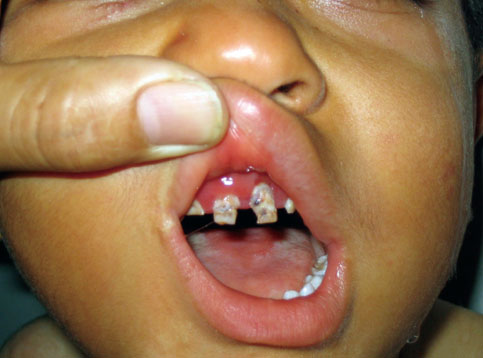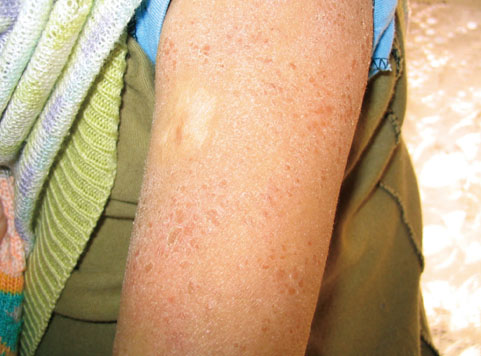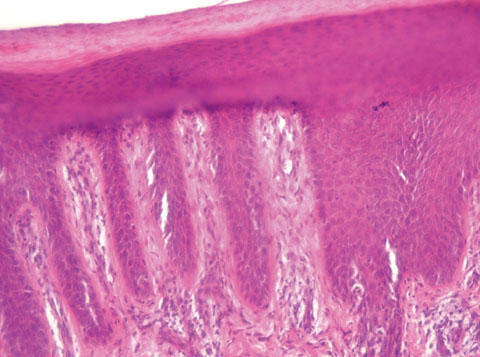Allergy Asthma Immunol Res.
2011 Apr;3(2):138-140. 10.4168/aair.2011.3.2.138.
A Rare Association Between Leukocyte Adhesion Deficiency Type I and Psoriasis in Humans
- Affiliations
-
- 1Department of Pediatrics, Ain Shams University, Cairo, Egypt. zeinabawad@gmail.com
- 2Department of Dermatology, Ain Shams University, Cairo, Egypt.
- 3Clinical Pathology, Ain Shams University, Cairo, Egypt.
- KMID: 2130368
- DOI: http://doi.org/10.4168/aair.2011.3.2.138
Abstract
- The beta2 integrins are expressed exclusively on leukocytes and participate in many immune and inflammatory processes. This subfamily comprises four heterodimeric glycoproteins with a common beta-subunit, designated beta2 (CD18). Spontaneous mutations of the CD18 gene result in leukocyte adhesion deficiency type I (LAD-I). Low level of CD18 expression has also been implicated in the pathogenesis of psoriasis. We here describe a child with recurrent skin infections without pus formation, persistent gingivitis and periodontitis. His blood counts showed persistent leukocytosis (neutrophilia). CD11b expression was defective on neutrophils, while that of CD18 was normal. So, our patient represents a mild variant of LAD-I with possible dysfunctional CD18. Moreover, he developed psoriasis with reduced CD18 expression on CD4+ T-cells. Psoriasiform dermatitis has been described before in association with LAD-I, however, clinically and histologically confirmed psoriasis in association with LAD-I has been described only in CD18 hypomorphic mice. Therefore, our patient represents the first clinically and histopathologically documented association between LAD-I and psoriasis in humans. It lends support to the role of beta2 integrins in the etiopathogenesis of psoriasis.
Keyword
MeSH Terms
Figure
Reference
-
1. Etzioni A, Harlan JM. Ochs HD, Smith CIE, Puck JM, editors. Cell adhesion and leukocyte adhesion defects. Primary immunodeficiency diseases: a molecular and genetic approach. 2007. 2nd ed. New York: Oxford University Press;551.2. Solomon E, Palmer RW, Hing S, Law SK. Regional localization of CD18, the beta-subunit of the cell surface adhesion molecule LFA-1, on human chromosome 21 by in situ hybridization. Ann Hum Genet. 1988. 52:123–128.3. Kilic SS. Leukocyte adhesion deficiency in a case presenting as septic arthritis. Int Pediatr. 2002. 17:96–97.4. Lebwohl M. Psoriasis. Lancet. 2003. 361:1197–1204.5. Diamond MS, Springer TA. The dynamic regulation of integrin adhesiveness. Curr Biol. 1994. 4:506–517.6. Hogg N, Stewart MP, Scarth SL, Newton R, Shaw JM, Law SK, Klein N. A novel leukocyte adhesion deficiency caused by expressed but nonfunctional beta2 integrins Mac-1 and LFA-1. J Clin Invest. 1999. 103:97–106.7. Mathew EC, Shaw JM, Bonilla FA, Law SK, Wright DA. A novel point mutation in CD18 causing the expression of dysfunctional CD11/CD18 leucocyte integrins in a patient with leucocyte adhesion deficiency (LAD). Clin Exp Immunol. 2000. 121:133–138.8. Farber EM, Nall L. Childhood psoriasis. Cutis. 1999. 64:309–314.9. Hellgren L. Psoriasis: the prevalence in sex, age and occupational groups in total populations in Sweden. Morphology, inheritance and association with other skin and rheumatic diseases. 1967. Stockholm: Almqvist and Wiksell;134–145.10. Toussaint S, Hideko K. Elder D, Elenitsas R, Jaworsky C, Johnson B, editors. Non infectious erythematous popular and squamous diseases of the skin. Lever's histopathology of the skin. 1997. 8th ed. Philadelphia: Lippincott-Raven;156–163.11. Barlow SC, Xu H, Weaver CT, Lindsey JR, Schoeb TR, Bullard DC. Development of dermatitis in CD18-deficient PL/J mice is not dependent on bacterial flora, and requires both CD4+ and CD8+ T lymphocytes. Int Immunol. 2004. 16:345–351.12. van de Kerkhof PC, Weemaes CM. Skin manifestations in congenital deficiency of leucocyte-adherence glycoproteins (CDLG). Br J Dermatol. 1990. 123:395–401.13. Kess D, Peters T, Zamek J, Wickenhauser C, Tawadros S, Loser K, Varga G, Grabbe S, Nischt R, Sunderkötter C, Müller W, Krieg T, Scharffetter-Kochanek K. CD4+ T cell-associated pathophysiology critically depends on CD18 gene dose effects in a murine model of psoriasis. J Immunol. 2003. 171:5697–5706.14. Kishimoto TK, Hollander N, Roberts TM, Anderson DC, Springer TA. Heterogeneous mutations in the beta subunit common to the LFA-1, Mac-1, and p150,95 glycoproteins cause leukocyte adhesion deficiency. Cell. 1987. 50:193–202.
- Full Text Links
- Actions
-
Cited
- CITED
-
- Close
- Share
- Similar articles
-
- Leukocyte Adhesion Deficiency Associated with Neonatal Septic Hip in a Late Preterm Infant
- Inhibition of Leukocyte Adhesion by Developmental Endothelial Locus-1 (Del-1)
- Two Cases of Combined Geographic Tongue and Fissured Tongue in Generalized Pustular Psoriasis
- A Case of Plaque-type Infantile Psoriasis on Both Flank
- Adenosine Deaminase Activities in Sera and Erythrocytes of Patients with Psoriasis




